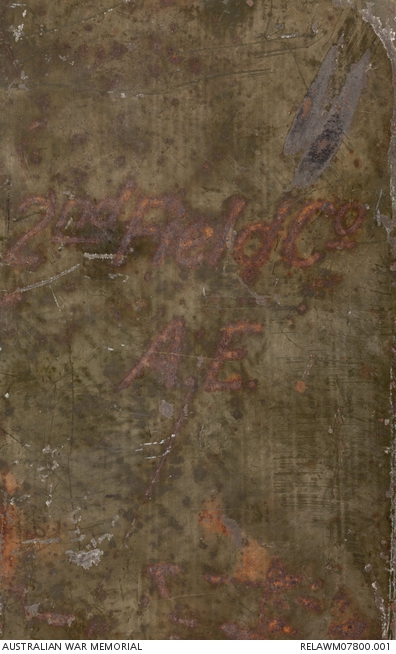| Place | Middle East: Ottoman Empire, Turkey, Dardanelles, Gallipoli, Bolton's Ridge, Shell Green |
|---|---|
| Accession Number | RELAWM07800.001 |
| Collection type | Technology |
| Object type | Optical equipment |
| Physical description | Steel |
| Maker |
Unknown |
| Date made | 1915 |
| Conflict |
First World War, 1914-1918 |
Trench Periscope : Shell Green, Gallipoli


Remains of a metal rectangular trench periscope. The body is made from a single piece of folded metal and is painted olive drab The paint is chipped in many areas and the metal has rusted in many of the revealed surfaces. The top and bottom are badly misshapen and are missing pieces. The mirrors from each end are also missing, although the diagonal metal supports for them are still in place. Approximately half way down the back of the periscope is a thin steel stake, attached to it with two butterfly screws, which can be folded behind the periscope. The front of the periscope has the following text scratched into it: '2nd Field Co / A.E.'
An original fabric Australian War Records Section collection label is tied to the periscope (see RELAWM07800.002)
This damaged periscope was found in January 1919 by Lieutenant William Hopkin James, who was working on Gallipoli, leading a small party from the Australian War Records Section, taking photographs and collecting items for the national collection. It was located, together with a megaphone (RELAWM00338), at Shell Green.
The periscope was used by members of the 2nd Field Company Engineers at Gallipoli, who landed at Anzac Cove at 7am on 25 April 1915, and, excluding some periods in camp at Lemnos, served at Gallipoli until December, with the last sections of the unit departing on the morning of 19 December.
At Gallipoli, the unit did much work building trenches, tunnels, shelters and other facilities around the Anzac area, including Shrapnel Gully, Lone Pine and Leane's Trench. They also assisted in the December evacuation by preparing the beach area for the departing troops (including the placements of sandbags on piers to muffle the sound of the soldiers' feet) and completing demolition work on material that had to be left behind.